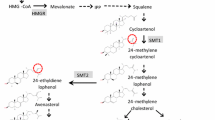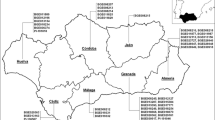Summary
Materials used in this study consisted of small and large seeded flax varieties Redwing and Beta 210, and of their reciprocal crosses and backcrosses. The seed weight means (mg's/seed) of reciprocal crosses were the same in F1 but significantly different in F2 and F3 generations indicating thus their nonequivalence with respect to this character. This nonequivalence was detectable also in the backcross reciprocals. On the assumption that Redwing and Beta 210. have different plasmatypes and the hybrid has the same plasmatype as its female parent, the available 24 families, including the parents as selfs, were grouped into two genomically the same but plasmatically supposedly different sets. A detailed analysis of the family means in these two sets led to the conclusion that the inheritance of the character considered was rather complicated. In F1 generation the Beta 210 set of genes was partially dominant over its allelic Redwing set ([h]<[d]). In the subsequent generations the Beta 210 set of genes has sustained a certain degree of loss of expressivity. This loss was 73% in the plasmatypically Redwing set of families and 20% in the plasmatypically Beta 210 set of families. This difference in the loss of expressivity and the gene-dosis effects, detected mainly in the plasmatypically Beta 210 set of families, indicated that the nature of the reciprocal cross nonequivalence observed in this study was both cytoplasmic and nuclear.
Zusammenfassung
Als Material für die vorstehenden Untersuchungen wurden die kleinkörnige Leinsorte Redwing, die großkörnige Beta 210 und ihre reziproken Kreuzungen und Rückkreuzungen verwendet. Die Mittelwerte des Samengewichtes (in mg/Samen) der reziproken Kreuzungen waren in der F1 gleich, unterschieden sich jedoch in der F2 und F3, ebenso wie in den reziproken Rückkreuzungen, signifikant voneinander und zeigten damit eine Ungleichwertigkeit hinsichtlich dieses Merkmals auf.
Ausgehend von der Annahme, daß Redwing und Beta 210 unterschiedliche Plasmotypen besitzen und der Bastard im Plasmotyp dem mütterlichen Elter entspricht, wurden die verfügbaren 24 Familien einschließlich der Selbstungen der Eltern in zwei genomatisch gleiche, jedoch plasmatisch unterschiedliche Gruppen klassifiziert. Eine detaillierte Analyse der Familienmittel innerhalb der Gruppen führt zu dem Schluß, daß die Vererbung des betrachteten Merkmals verhältnismäßig kompliziert ist. In der F1 war die Menge der Beta 210-Gene über die allele Menge der Redwing-Gene partiell dominant ([h]<[d]). In den folgenden Generationen erleidet die Menge der Beta 210-Gene eine gewisse Einbuße an Expressivität. Dieser Verlust beträgt 73% in den Familien des Plasmotyps Redwing und 20% in den Familien des Plasmotyps Beta 210. Dieser Unterschied im Verlust der Expressivität und die Dosiseffekte, die vornehmlich in den Familien mit dem Plasmotyp Beta 210 nachgewiesen werden, zeigen, daß die Ursache der Ungleichwertigkeit der reziproken Kreuzungen sowohl plasmatisch als auch kernbedingt ist.
Similar content being viewed by others
Literature
Aksel, R.: Analysis of means in the case of non-equivalent reciprocal crosses. Theor. Appl. Gen. (1974).
Chandraratna, M. F., Sakai, Kan-Ichi: A biometrical analysis of matroclinous inheritance of grain weight in rice. Heredity 14, 365–373 (1960).
Chebotareff, A. S.: The least square method with fundamentals of probability theory (in Russian). Moscow, USSR: Geodezizdat 1958.
Mather, K.: Biometrical Genetics. London: Methuen & Co. 1949.
Mather, K., Jinks, J. L.: Biometrical Genetics. Ithaca, New York: Cornell University Press 1971.
Smith, W. E., Fitzsimmons, J. E.: Maternal Inheritance of seed weight in flax (Linum usitatissimum L.). Can. J. Genet. Cytol. VI, 244 (1964).
Smith, W. E., Fitzsimmons, J. E.: Maternal inheritance of seed-weight in flax (Linum usitatissimum L.). Can. J. Genet. Cytol. VII. 658–662 (1965).
Author information
Authors and Affiliations
Additional information
Communicated by H. Stubbe/W. Seyffert
Rights and permissions
About this article
Cite this article
Smith, W.E., Aksel, R. Genetic analysis of seed-weight in reciprocal crosses of flax (Linum usitatissimum L.). Theoret. Appl. Genetics 45, 117–121 (1974). https://doi.org/10.1007/BF00291140
Received:
Issue Date:
DOI: https://doi.org/10.1007/BF00291140




